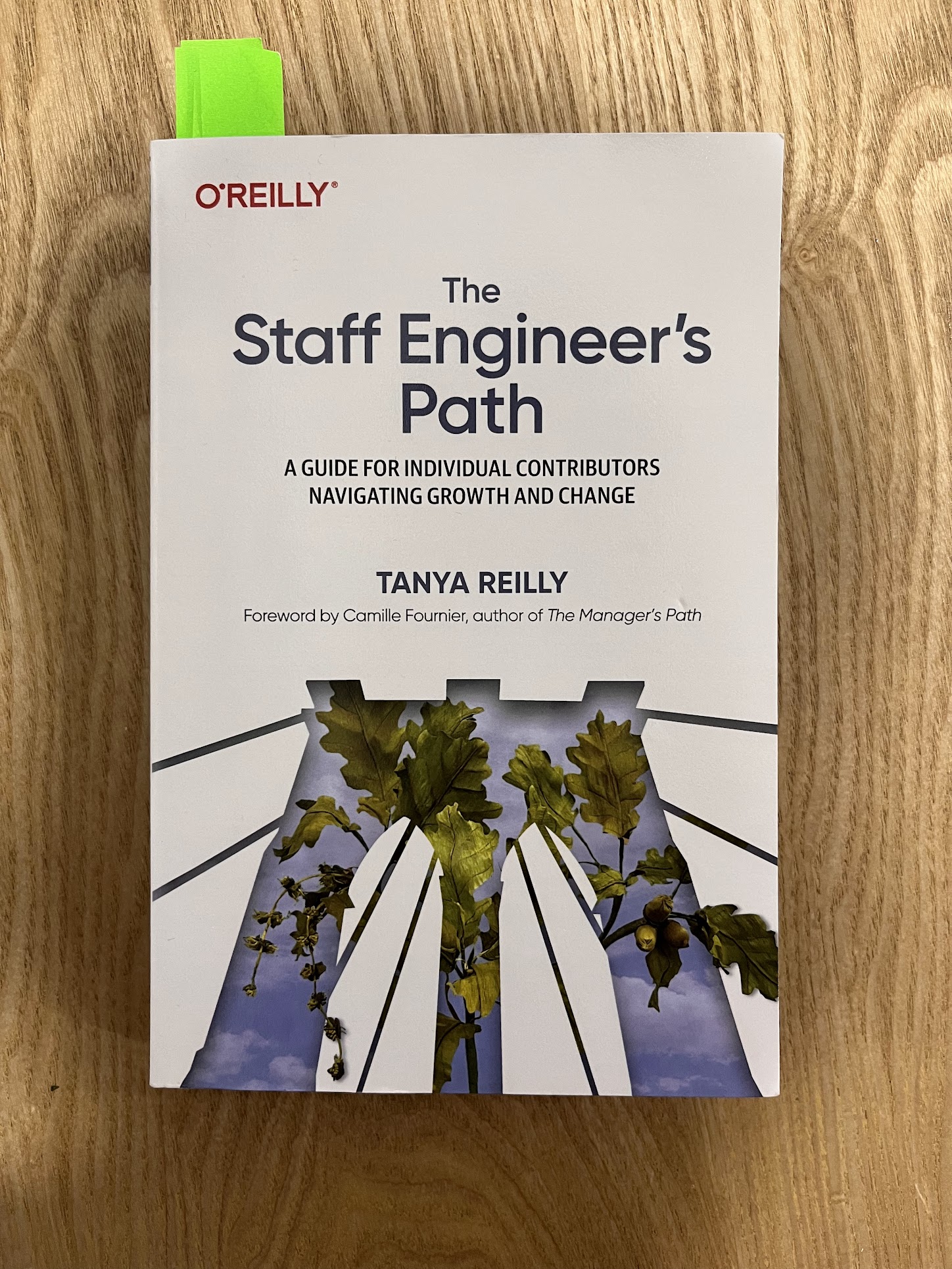The Staff Engineer’s Path: A Guide for Individual Contributors Navigating Growth and Change is written by Tanya Reilly and published on October 25, 2022, by O’Reilly Media.

Favorite Quotes
Early in your career, if you do a great job on something that turns out to be unnecessary, you’ve still done a great job. At the staff engineer level, everything you do has a high opportunity cost, so your work needs to be important.
You build credibility every time you take on a chaotic situation and make it easier for everyone else to understand.
Know why the problem you’re working on is strategically important, and if it’s not, do something else.
Whenever there’s a feeling of “someone should do something here”, there s a reasonable chance that this someone is you.
Writing about engineering strategy is hard because good strategy is pretty boring, and it’s kind of boring to write about. If you write something interesting, it’s probably wrong.
What is inside
The first thing the book addresses is the question: Who is the staff engineer, and how are they different from IC and management roles? What are their priorities, skills, scopes, expectations, and position at the corporate charts and ladders?
The best take from this part for me was a technique to align the shape of your position with you and your peers and managers. It suggests creating an informal role description document where you state your goals, the vision of success for you, and the results that you aim to achieve. I would even say that this is a very proactive and helpful practice in general, not only for staff positions.
The next parts, “Three Maps” and “Creating the Big Picture” describe how to understand and identify important parts of company structure. They address many parts of it: technical landscape, formal and informal organizational charts, and places where decisions happen(if it exists, and sometimes it doesn’t).
Those parts recommend how to build knowledge about those systems by sourcing information and creating maps of where we at right now, our goals, and the landscape that surrounds the path to a goal.
Very simple yet somewhat unconventional advice on building this knowledge was getting data from open resources:
- mailing lists and channels with updates
- open calendars and events
- newly created slack channels
- informal discussions
Part “Finite time” is dedicated to personal management practices and prioritization of projects and tasks you take, so you and your business can get the most value from it.
It’s an odd default, that work calendars show only meetings. If you are doing focused work, then the calendar shows interruptions of this work.
Put non-meetings on the calendar:
- Mail/slack checks
- coffee, lunches, and short 1:1s
- Documentation and coding
It introduces a simple yet beneficial technique to prioritize possible projects: Impact Effort Matrix.
The meatiest part is in the middle of the book, told through the “Leading big projects” and “Why Have We Stopped” chapters.
It goes deep into practices of leading ambiguous projects and domains: navigating terrain, and laying down the paths. It provides very useful techniques for navigating projects in time and considering the higher-level picture of organization goals, answering questions about how to identify a place and time to start, stop or finish the project.
There is a very large detailed section about resolving blocked and stuck projects with detailed examples. There were a lot of tips that matched many projects in my experience, It felt close to home. This is part that I definitely see myself revisiting many times.
A large part is dedicated to setting up goals for big projects, and there is a fantastic template and framework for RFC documents.
Later parts, “You are role model now” and “Good Influence at Scale” are dedicated to how to apply higher standards to yourself and leading by example
Your company might have a written definition of what good engineering means - written values, and engineering principles. But the clearest indicator of what the company values is what gets people promoted.
I found those two parts very lengthy and touched too many topics at once. Both address knowledge-sharing practices, influencing and leading, being “an adult in the room” and defusing conflicts at different scales. Many very useful examples of how your work can make processes smoother and serve as a “glue” between teams.
if a junior person is taking meeting notes, they are unable to participate. If senior is takes notes, they are making sure that meeting is effective
Finally, the concluding “What’s next” part takes a step back to talk about career choices, when is the good time to change projects and companies at the staff level, how to grow your social connections, and how to maintain a healthy work-life balance.
Who Will Find It Useful
- Senior Engineers looking for the next career step
- Engineers and Engineering Managers looking to establish team and cross-team communications.
- Engineers, Engineering Managers, Tech, and team leads working on ambiguous and large-scale projects and looking for frameworks to define, shape, and deliver.